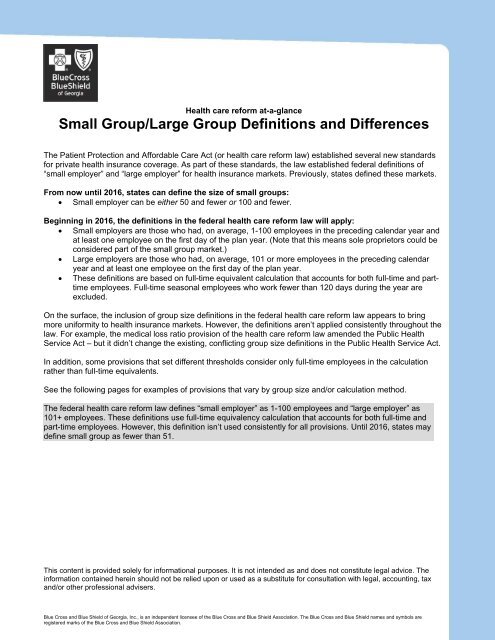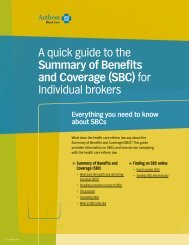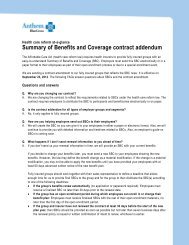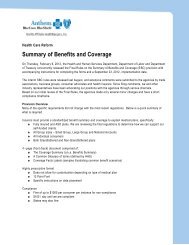Small Group/Large Group Definitions and Differences
Small Group/Large Group Definitions and Differences
Small Group/Large Group Definitions and Differences
Create successful ePaper yourself
Turn your PDF publications into a flip-book with our unique Google optimized e-Paper software.
Health care reform at-a-glance<br />
<strong>Small</strong> <strong>Group</strong>/<strong>Large</strong> <strong>Group</strong> <strong>Definitions</strong> <strong>and</strong> <strong>Differences</strong><br />
The Patient Protection <strong>and</strong> Affordable Care Act (or health care reform law) established several new st<strong>and</strong>ards<br />
for private health insurance coverage. As part of these st<strong>and</strong>ards, the law established federal definitions of<br />
“small employer” <strong>and</strong> “large employer” for health insurance markets. Previously, states defined these markets.<br />
From now until 2016, states can define the size of small groups:<br />
<strong>Small</strong> employer can be either 50 <strong>and</strong> fewer or 100 <strong>and</strong> fewer.<br />
Beginning in 2016, the definitions in the federal health care reform law will apply:<br />
<strong>Small</strong> employers are those who had, on average, 1-100 employees in the preceding calendar year <strong>and</strong><br />
at least one employee on the first day of the plan year. (Note that this means sole proprietors could be<br />
considered part of the small group market.)<br />
<strong>Large</strong> employers are those who had, on average, 101 or more employees in the preceding calendar<br />
year <strong>and</strong> at least one employee on the first day of the plan year.<br />
These definitions are based on full-time equivalent calculation that accounts for both full-time <strong>and</strong> parttime<br />
employees. Full-time seasonal employees who work fewer than 120 days during the year are<br />
excluded.<br />
On the surface, the inclusion of group size definitions in the federal health care reform law appears to bring<br />
more uniformity to health insurance markets. However, the definitions aren’t applied consistently throughout the<br />
law. For example, the medical loss ratio provision of the health care reform law amended the Public Health<br />
Service Act – but it didn’t change the existing, conflicting group size definitions in the Public Health Service Act.<br />
In addition, some provisions that set different thresholds consider only full-time employees in the calculation<br />
rather than full-time equivalents.<br />
See the following pages for examples of provisions that vary by group size <strong>and</strong>/or calculation method.<br />
The federal health care reform law defines “small employer” as 1-100 employees <strong>and</strong> “large employer” as<br />
101+ employees. These definitions use full-time equivalency calculation that accounts for both full-time <strong>and</strong><br />
part-time employees. However, this definition isn’t used consistently for all provisions. Until 2016, states may<br />
define small group as fewer than 51.<br />
This content is provided solely for informational purposes. It is not intended as <strong>and</strong> does not constitute legal advice. The<br />
information contained herein should not be relied upon or used as a substitute for consultation with legal, accounting, tax<br />
<strong>and</strong>/or other professional advisers.<br />
Blue Cross <strong>and</strong> Blue Shield of Georgia, Inc., is an independent licensee of the Blue Cross <strong>and</strong> Blue Shield Association. The Blue Cross <strong>and</strong> Blue Shield names <strong>and</strong> symbols are<br />
registered marks of the Blue Cross <strong>and</strong> Blue Shield Association.
Key Provisions that Differ for <strong>Small</strong> <strong>Group</strong> <strong>and</strong> <strong>Large</strong> <strong>Group</strong><br />
Note: This table applies to group sizes as noted in the health care reform law. It does not account for<br />
differences in our business decisions for implementation.<br />
Provision<br />
<strong>Small</strong><br />
Business Tax<br />
Credit<br />
Starts 2010<br />
<strong>Small</strong> <strong>Group</strong><br />
Applicability<br />
Yes<br />
Up to 25<br />
employees with<br />
average wages<br />
less than $50,000<br />
<strong>Large</strong> <strong>Group</strong><br />
Applicability<br />
No<br />
More Details<br />
Beginning in 2014, the credit is<br />
allowable for only a two-year period<br />
<strong>and</strong> only if coverage is purchased<br />
through the exchange.<br />
Minimum<br />
Medical Loss<br />
Ratio<br />
Starts 2011<br />
<strong>Small</strong><br />
Employer<br />
Wellness<br />
Grants<br />
Starts 2011<br />
Employer<br />
Responsibility<br />
(“Play or Pay”)<br />
Starts 2014<br />
Based on fulltime<br />
equivalency<br />
(full-time <strong>and</strong><br />
part-time)<br />
Yes<br />
HHS defined<br />
small group as 1<br />
- 100 but permits<br />
states to maintain<br />
the upper limit at<br />
50 until 2016<br />
Yes<br />
Up to 100<br />
employees<br />
Based on fulltime<br />
(25+ hrs/wk)<br />
only<br />
Yes for larger<br />
small groups<br />
50 or more<br />
employees<br />
Based on fulltime<br />
equivalency<br />
(full-time <strong>and</strong><br />
part-time)<br />
Yes<br />
HHS defined<br />
large group as<br />
101+ but would<br />
permit a state to<br />
reduce to 51+<br />
until 2016<br />
No<br />
Yes<br />
50 or more<br />
employees<br />
Based on fulltime<br />
equivalency<br />
(full-time <strong>and</strong><br />
part-time)<br />
Minimum medical loss ratio is 80% for<br />
small group <strong>and</strong> 85% for large group.<br />
Plans that don’t meet these minimums<br />
would need to provide rebates.<br />
Grants for health education,<br />
screenings <strong>and</strong> wellness programs<br />
available only to eligible employers<br />
who implement the programs after<br />
March 23, 2010. Funding ends in<br />
2015.<br />
Penalties assessed if:<br />
Employer doesn’t provide<br />
minimum coverage<br />
or<br />
Employer offers coverage but<br />
actuarial value less than 60%<br />
or employee cost is more than<br />
9.5% of household income<br />
Blue Cross <strong>and</strong> Blue Shield of Georgia, Inc., is an independent licensee of the Blue Cross <strong>and</strong> Blue Shield Association. The Blue Cross <strong>and</strong> Blue Shield names <strong>and</strong> symbols are<br />
registered marks of the Blue Cross <strong>and</strong> Blue Shield Association.
Provision<br />
Essential<br />
Health<br />
Benefits<br />
Package<br />
Required<br />
Starts 2014<br />
Option to<br />
Purchase<br />
Through<br />
Exchange<br />
Starts 2014<br />
Community<br />
Rating<br />
Starts 2014<br />
<strong>Small</strong> <strong>Group</strong><br />
Applicability<br />
Yes<br />
Follows state<br />
definition until<br />
2016, then<br />
follows health<br />
care reform law<br />
definition<br />
Yes<br />
Follows state<br />
definition until<br />
2016, then<br />
follows the health<br />
care reform<br />
definition<br />
Yes<br />
Follows state<br />
definition until<br />
2016, then<br />
follows health<br />
care definition<br />
<strong>Large</strong> <strong>Group</strong><br />
Applicability<br />
No<br />
To be<br />
determined<br />
No<br />
More Details<br />
The essential health benefits package<br />
will include services such as<br />
ambulatory patient services,<br />
emergency services, hospitalization,<br />
maternity <strong>and</strong> newborn care, mental<br />
health substance use disorder<br />
services, prescription drugs,<br />
rehabilitative <strong>and</strong> habilitative services<br />
<strong>and</strong> devices, preventive <strong>and</strong> wellness<br />
services <strong>and</strong> pediatric services.<br />
States may allow 101+ employers to<br />
purchase coverage in exchanges<br />
starting in 2017.<br />
Requires issuers to vary premiums<br />
based only on self-only or family<br />
enrollment, rating area, age <strong>and</strong><br />
tobacco use.<br />
Questions <strong>and</strong> Answers<br />
How will you calculate medical loss ratio separately for small <strong>and</strong> large groups in 2011<br />
The Affordable Care Act amended the definitions of large <strong>and</strong> small employer in the Public Health Service Act,<br />
defining a small employer as 1-100 employees <strong>and</strong> a large employer as 101 or more employees. However, the<br />
Affordable Care Act also allows states to continue to define an employer with up to 50 employees as a “small<br />
employer” until 2016. For states that do so, that definition shall apply to the medical loss ratio reporting <strong>and</strong><br />
rebate requirements.<br />
Blue Cross <strong>and</strong> Blue Shield of Georgia, Inc., is an independent licensee of the Blue Cross <strong>and</strong> Blue Shield Association. The Blue Cross <strong>and</strong> Blue Shield names <strong>and</strong> symbols are<br />
registered marks of the Blue Cross <strong>and</strong> Blue Shield Association.






